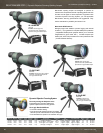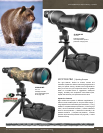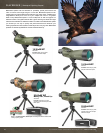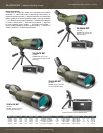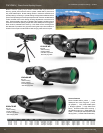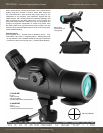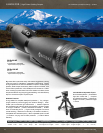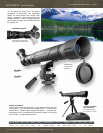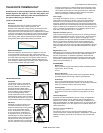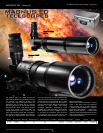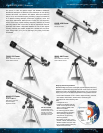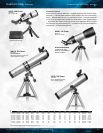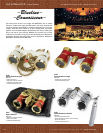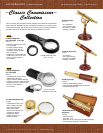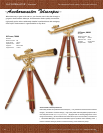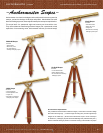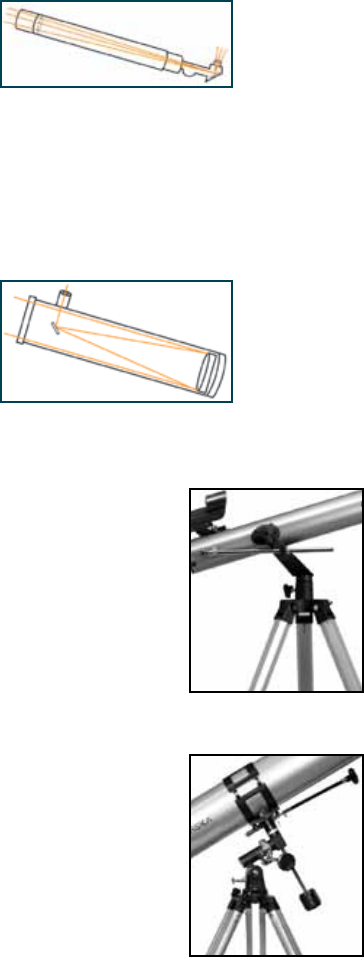
ascension) adjusted to your latitude and that axis is aligned to make
it parallel to the Earth’s axis, so that if that axis is turned at the same
rate of speed as the Earth, but in the opposite direction, objects will
appear to sit still when viewed through the telescope. Equatorial
mounts are preferable for deep sky observing.
Focal Length
Focal length is the distance (in mm.), in an optical system. It is a
measurement from the lens (or primary mirror) to the point where the
telescope is in focus (focal point). The longer the focal length of the
telescope, generally the more power it has, the larger the image and the
smaller the eld of view. Use the following formula to determine the focal
length of a telescope: Focal length is the aperture (in mm) times the focal
ratio. For example, the focal length of an 8” (203.2mm) aperture with a
focal ratio of f/10 would be 203.2 x 10 = 2032mm.
Objective Lens Size (Aperture)
Aperture size is the single most important factor in choosing a telescope.
Aperture is the diameter of the lens or mirror (in mm.). Since the primary
function of a telescope is to collect or “gather” incoming light, at any
given magnication the larger the aperture the better the viewed image
will be. It is important to remember that the larger the objective lens
mirror the better, but the size of the lens or mirror diameter limits the
amount of power that can be used. The higher the magnication, the less
bright the image will be since more light will be distributed over a larger
area.
Magnication (Power)
Magnication is the number of times the object being viewed is enlarged.
The magnication of a telescope is a function of the focal lengths of
the tube and eyepieces. To calculate magnication: Divide the focal
length of optical tube by the focal length of eyepiece that is being used.
For example, a 700mm telescope with a 4mm eyepiece would magnify
objects 175x (700 divided by 4).
ACCESSORIES
Barlow Lens
This is an auxiliary eyepiece lens that increases (multiplies) power by
a given factor, which is usually
2x or 3x.
Erecting Eye Prism
This lens corrects the inverted (upside down) image when viewing
land-based objects seen through a reector type telescope.
Finderscope
This is a low-powered sighting scope mounted on the top of the
telescope’s optical tube and has a reticle or an illuminated red dot that
allows you to quickly locate the object being viewed.
Focusing Knob
Controls the rack and pinion focusing system and enables smooth
and precise movement of the eyepiece to bring objects into sharp
focus.
Telescope Eyepieces
Eyepieces are interchangeable and provide a variety of magnication
and eld of view options. Use an eyepiece with low magnication to
view the Moon, planets, star clusters, nebulae and constellations. The
lower the magnication, the wider the eld of view. An eyepiece with high
magnication enables you to view details in the mountains, ridges and
craters of the Moon.
Telescope Limited Liftime Warranty
(Within USA and Canada only)
This warranty does not cover consumer-caused damages, abuse,
normal wear-and-tear, unauthorized repairs or modications. For further
detailed information, please refer to the warranty policy enclosed with
products.
TELESCOPE TERMINOLOGY
A telescope is an optical instrument that is used to observe
distant objects in the night sky. There are many styles and
sizes of telescopes. Selecting a size and style depends on
the type of observing you intend to do.
TYPES OF TELESCOPES
Refractors
Refractors are also known as “dioptrics”. Refractors are
characterized by are a long narrow optical tube. The
diameter of the optical tube (usually denoted in millimeters) varies
with the size of the objective (front) lens size. Light passes in a
straight line from the front objective lens to a diagonal mirror located
in the rear of the optical tube and directly to the eyepiece. Refractor
telescopes are suitable for both celestial (night sky) and terrestrial
(land) viewing. Note: Objects viewed through a refractor appear
wrong reading left to right but right reading up and down.
Newtonian Reectors
Newtonians Reectors are also known as “catoptrics”. They use
a concave parabolic primary mirror which collects and focuses
incoming light onto a at secondary (diagonal) mirror. The secondary
mirror then reects the image out of an opening at the side of the
main optical tube and into the eyepiece. Reector telescopes are
most suitable for celestial (night sky) viewing. Note: Objects viewed
through a reector appear vertically inverted.
TELESCOPE MOUNTS
Altazimuth
The altazimuth (AltAz) is the simplest
type of mount. It has two motions – up
and down (altitude) and side-to-side/
horizontal (azimuth). Better quality
altazimuth mounts will have slow-motion
knobs for making precise adjustments
and aid in keeping tracking motion
smooth. Altazimuth mounts are good for
terrestrial (land) viewing and for scanning
the night sky at lower power. They are not
recommended for deep sky photography.
Equatorial
Equatorial mounts are superior to non-
computerized altazimuth mounts for
astronomical observing over long periods
of time. As the earth rotates around
its axis, the stationary stars appear to
move across the sky. A telescope on
an equatorial mount can be aimed at a
celestial object and easily guided using
the manual slow-motion controls to follow
the object across the sky and keep it in
the view of the telescope. The equatorial
mount is rotated on one axis (polar/right
Equatorial
w w w . b a r s k a . c o m
Altazimuth
2011 BARSKA Sport Optics Catalog
76



